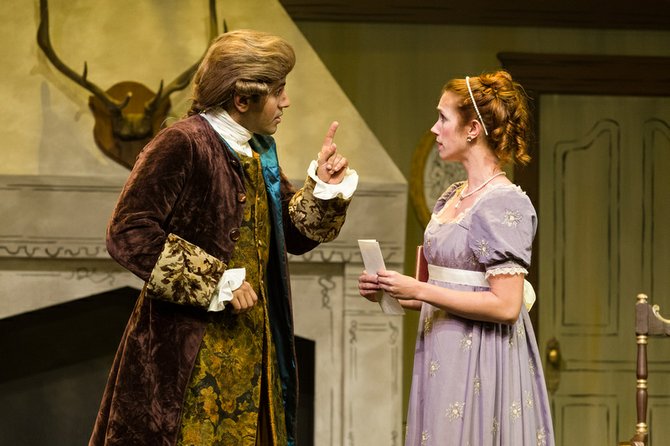 Facebook
Facebook
 X
X
 Instagram
Instagram
 TikTok
TikTok
 Youtube
Youtube

Oliver Goldsmith is proof that writers come in all shapes, sizes, and temperaments. His detractors said he couldn’t hold his life together. Their proof: he wrote thousands of pages of hackwork to pay for gambling debts and alcohol. But he also penned one of the great comedies of the 18th century and, in the expert hands of Penny Metropulos, a guest director at UCSD, it’s just as funny today.
Wealthy young Marlow has two personalities. Around lower class women he’s as bawdy as the next bloke, at least verbally. Upper class women intimidate him so much his only thought is making a swift and graceful exit.
Marlow’s father Sir Charles and his friend, Mr. Hardcastle, want to arrange a marriage between young Marlow and Hardcastle’s smart, spritely daughter Kate.

She’s two people as well: in the morning she receives visitors in formal attire; in the evening, to show her duty to her father, she wears a more modest outfit. The latter comes in handy. In their first “interview,” Marlow shriveled in her presence. So Kate will pose as a barmaid and coax out the earthier man. By stooping in social class, she will conquer him.
The title comes from Aphra Behn’s The Rover. And She Stoops could serve as a textbook case of dramatic irony. Much of the humor comes from the audience knowing more than the characters, as when Marlow assumes Mr. Hardcastle’s just a lowly innkeeper and treats his potential father-in-law with ardent disrespect.
There are all kinds of essays, even books, on how to act in 18th century comedies. How stiff were they? Were they an ensemble, or did they speak unbeknownst to each other? Director Metropulos’ answer is simple: have fun — and make the audience your ally.
Goldsmith’s people often speak in asides. One of the show’s best parts: the asides don’t just inform. The actors often play “front.” They face and address the audience directly. And the asides become a chance for the actor grab the spotlight. It’s not blatant hamming. But it might be how Goldsmith’s cast stepped out of character and announced “Hey, I’m here too!” — then slid back into the action. The asides are engaging and endearing. In keeping with this approach, the director has some actors take bows even before they act.
As Marlow and Kate, Michael Hammond and Emily Shain demonstrate admirable flexibility when they shift from up-market formality to down-home rascality. Tom Patterson (Mr. Hastings), William Hodgson (Tony Lumpkin), and especially Tesjana Elie (whose Mrs. Hardcastle can rule the stage on call) head a strong supporting cast.
The UCSD production combines the period — footlights and flats of trees and clouds conjure the era — with more realistic touches (Jenna Carino’s two-level set sports a large fireplace, proximity to which announces one’s social status). Amy Sutton’s costumes and Andrew Vargas’ original music complete the portrait with precision in this very funny show.


Oliver Goldsmith is proof that writers come in all shapes, sizes, and temperaments. His detractors said he couldn’t hold his life together. Their proof: he wrote thousands of pages of hackwork to pay for gambling debts and alcohol. But he also penned one of the great comedies of the 18th century and, in the expert hands of Penny Metropulos, a guest director at UCSD, it’s just as funny today.
Wealthy young Marlow has two personalities. Around lower class women he’s as bawdy as the next bloke, at least verbally. Upper class women intimidate him so much his only thought is making a swift and graceful exit.
Marlow’s father Sir Charles and his friend, Mr. Hardcastle, want to arrange a marriage between young Marlow and Hardcastle’s smart, spritely daughter Kate.

She’s two people as well: in the morning she receives visitors in formal attire; in the evening, to show her duty to her father, she wears a more modest outfit. The latter comes in handy. In their first “interview,” Marlow shriveled in her presence. So Kate will pose as a barmaid and coax out the earthier man. By stooping in social class, she will conquer him.
The title comes from Aphra Behn’s The Rover. And She Stoops could serve as a textbook case of dramatic irony. Much of the humor comes from the audience knowing more than the characters, as when Marlow assumes Mr. Hardcastle’s just a lowly innkeeper and treats his potential father-in-law with ardent disrespect.
There are all kinds of essays, even books, on how to act in 18th century comedies. How stiff were they? Were they an ensemble, or did they speak unbeknownst to each other? Director Metropulos’ answer is simple: have fun — and make the audience your ally.
Goldsmith’s people often speak in asides. One of the show’s best parts: the asides don’t just inform. The actors often play “front.” They face and address the audience directly. And the asides become a chance for the actor grab the spotlight. It’s not blatant hamming. But it might be how Goldsmith’s cast stepped out of character and announced “Hey, I’m here too!” — then slid back into the action. The asides are engaging and endearing. In keeping with this approach, the director has some actors take bows even before they act.
As Marlow and Kate, Michael Hammond and Emily Shain demonstrate admirable flexibility when they shift from up-market formality to down-home rascality. Tom Patterson (Mr. Hastings), William Hodgson (Tony Lumpkin), and especially Tesjana Elie (whose Mrs. Hardcastle can rule the stage on call) head a strong supporting cast.
The UCSD production combines the period — footlights and flats of trees and clouds conjure the era — with more realistic touches (Jenna Carino’s two-level set sports a large fireplace, proximity to which announces one’s social status). Amy Sutton’s costumes and Andrew Vargas’ original music complete the portrait with precision in this very funny show.
Comments